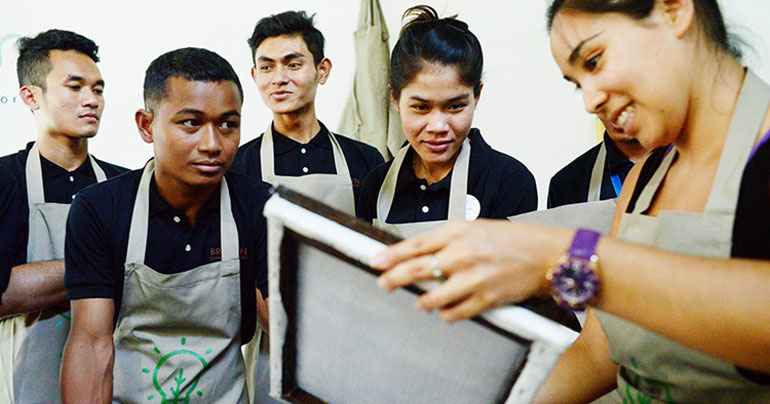A social enterprise in Siem Reap is coming up with innovative solutions to the ever-accumulating wastes at the tourism hot spot of Siem Reap. It “upcycles” refuse into biofuel, soap and durable goods

Siem Reap is Cambodia’s tourism cash cow. Over a million visitors fly directly to the city every year, and the city and nearby temples attracted more than 5.6 million people in 2017, a number that has been rising over the past 20 years.
Such an influx of tourists presents environmental challenges. Cambodia already has a variety of environmental issues like illegal logging and a lack of recycling facilities, let alone the waste of millions of tourists. Tim Waterfield wants to help as the founder of Naga Earth, a social enterprise that’s trying to make tourism greener in Siem Reap.
Cooking oils are often emptied down drains by street food vendors, which can lead to environmental issues down the line. Naga Earth collects used cooking oil and turns it into biodiesel fuel. The outfit got started ten years ago with biofuel when Waterfield, an American mechanical engineer, partnered with a Siem Reap hospital to power it with biodiesel. Years later, the enterprise has expanded beyond that original first step.
“Now we’re working with a number of businesses that use our biofuel,” said Waterfield. He counts Angkor Golf Resort and Grasshopper Adventures among the 20 businesses now using his biofuel.

Waterfield explained how tourism benefits the environment in Siem Reap: “Siem Reap works very hard as a community to keep the community clean, and there’s a lot of environmental initiatives in Siem Reap…. I would say the environmental awareness in Siem Reap is much higher than most other places [in Cambodia]. We have a very good rubbish collection in Siem Reap. People do pretty well recycling [here].”
The increasing demand for environmental sustainability is driving positive changes, said Waterfield.
“Part of it is that green business makes good businesses for a lot of people, and I think many of the Cambodians recognise this. I think over the years they’ve had many requests from international visitors for green opportunities like green hotels to stay in, green tours to do, things like this.”
Beyond recycling oil, Naga Earth turns the glycerin by-product from its oil processes into biodegradable soap. It distributes the soap to schools, non-profits and NGOs, and has a programme that teaches children about hygiene, which Waterfield noted is “one of the most prominent problems facing Cambodian children”.
And Naga’s various initiatives, Waterfield explained, have a negligible environmental impact.
“All of our distribution we’re trying to do zero-waste and eco-friendly,” he said. “So, for example, all of our containers are reusable…. We’re giving them upcycled soap and then in a reusable bottle.”
[manual_related_posts]
The central idea behind Naga Earth is “upcycling” – turning a used product into a more premium product. This includes turning used cooking oil into two products worth more than the original. Naga Earth also collects plastic straws from hotels and restaurants in Siem Reap, and turns them into more durable and reusable items. Naga Earth recently partnered with GAEA, the local trash collection company, in a glass recycling project. Naga will collect glass bottles and turn them into gravel pieces to be used for water filtering.
Waterfield wants Naga Earth to focus more on the soap side of the business. As for its recycling projects, despite the challenges brought by millions of tourists, he is positive about the community’s recycling ambitions.
“I think the community response [to increased tourism] is good, and as a result, Siem Reap is ahead of most other communities…. I think there’s plenty of Cambodians that are environmentalists just like many Westerners are, but in Cambodia, we also have the drive from the tourism [sector] to be green.”
Naga Earth
Turning Temple Town green through 'upcycling'
A social enterprise in Siem Reap is coming up with innovative solutions to the ever-accumulating wastes at the tourism hot spot of Siem Reap. It “upcycles” refuse into biofuel, soap and durable goods

